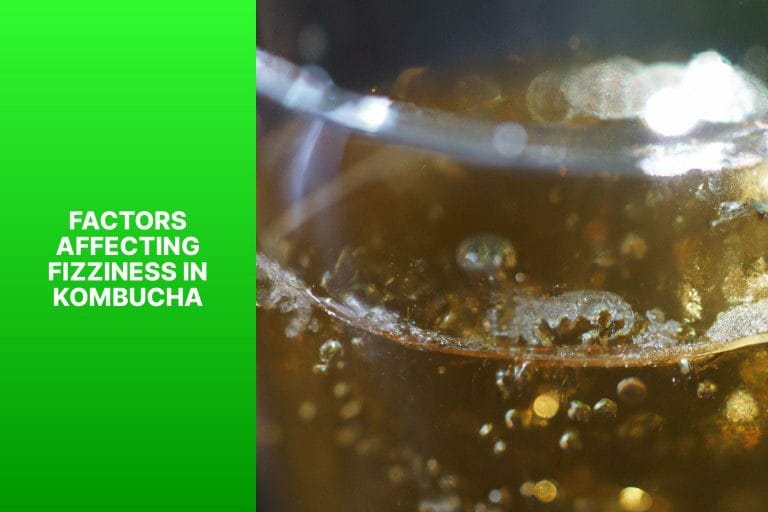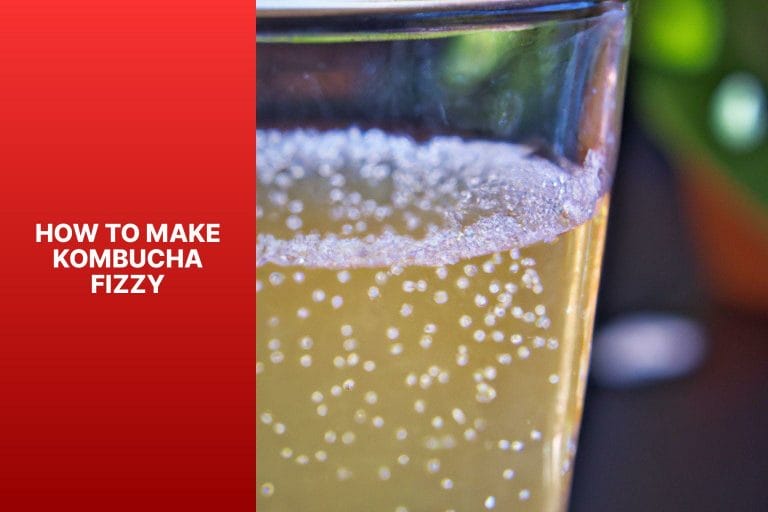Kombucha, a fermented tea beverage, has gained popularity for its potential health benefits and unique taste. While kombucha itself is delicious, the fizzy characteristic adds an extra element of enjoyment to the drinking experience.
In this article, we will explore the process of making kombucha fizzy and discuss the factors that affect its fizziness.
Kombucha is a probiotic-rich beverage that ferments sweetened tea using a symbiotic culture of bacteria and yeast (SCOBY).
During fermentation, the yeast consumes the sugar and produces carbon dioxide, creating fizzy bubbles in kombucha.
Fizziness is important in kombucha for several reasons. It enhances the sensory experience, making it more enjoyable to drink. The carbonation can aid in digestion and provide a refreshing feel.
The fizziness is often a sign of a healthy fermentation process, indicating that the beneficial bacteria and yeast are thriving.
Several factors can affect the fizziness of kombucha. Fermentation time is crucial, as a longer fermentation period allows more carbonation to develop.
Temperature influences the activity of the yeast, with warmer temperatures leading to increased carbonation. The sugar content in the initial brew also impacts fizziness, as yeast requires sugar to produce carbon dioxide.
A second fermentation stage, where kombucha is bottled and left to ferment further, can enhance the fizzy nature.
To make kombucha fizzy, it is essential to focus on proper fermentation. Allowing the first fermentation to occur for an adequate duration enables sufficient carbon dioxide production.
Bottle conditioning, where kombucha is bottled and sealed tightly, further promotes carbonation. Adding flavorings, such as fruit or herbs, can contribute to the fizziness by creating additional fermentation activity.
Proper storage and temperature control during the second fermentation phase is crucial to achieving desired carbonation levels.
In the event of troubleshooting, common issues with fizziness include flat kombucha, which can be resolved by extending the fermentation time or adding sugar before bottling.
On the other hand, overly fizzy kombucha can be addressed by using stronger bottles, burping excess gas during the second fermentation, or reducing the fermentation time.
By understanding the process and factors affecting kombucha’s fizziness, you can experiment and create your own fizzy and flavorful kombucha at home.
Key takeaway:
- Fizziness is important in Kombucha: The fizzy texture adds to the overall experience and taste of kombucha, making it more enjoyable for consumers.
- Factors affecting Fizziness in Kombucha: Fermentation time, temperature, sugar content, and second fermentation all play crucial roles in achieving the desired level of fizziness in kombucha.
- How to make Kombucha fizzy: Proper fermentation, bottle conditioning, adding flavorings, and storing at the right temperature are essential to creating fizzy kombucha with optimal taste and texture.
- Troubleshooting common issues with fizziness: Understanding and addressing problems such as flat Kombucha or overly fizzy Kombucha can help ensure consistent and desired carbonation levels in the final product.
What is Kombucha?
Kombucha is a tea made by fermenting brewed tea, sugar, and a culture of bacteria and yeast called a SCOBY. So, what is kombucha exactly?
The yeast consumes the sugar and makes alcohol, while the bacteria turns the alcohol into organic acids. This process results in a tart and slightly fizzy drink with a vinegary taste.
Kombucha is not just any ordinary drink but is renowned for its potential health benefits. It contains probiotics, antioxidants, and enzymes that may support digestion and well-being.
Fascinatingly, kombucha has a long history. It originated in Northeast China around 220 BC and has gained popularity worldwide.
One great thing about kombucha is its versatility. It can be enjoyed plain or enhanced with flavors of fruit, herb, or spices. It is crucial to remember that making homemade kombucha can be risky if not done properly.
Purchasing commercial brands or following strict hygiene practices when brewing it at home is recommended to ensure safety.
Why is Fizziness Important in Kombucha?
“Fizziness is crucial in kombucha because it plays a significant role in enhancing the taste experience and indicating successful fermentation.
Carbonation in effervescent kombucha enhances the pleasure of consuming it and elevates the perception of flavors.
The fizzy nature of kombucha signifies the existence of beneficial probiotics and organic acids that contribute to the cultivation of gut health.
Remember that the level of fizziness can vary depending on factors such as the duration of fermentation or the utilization of secondary fermentation.
To boost the fizziness in your homemade kombucha, it is advisable to extend the fermentation period, properly prime the sugar, ensure correct bottling techniques, and experiment with various flavors.
By comprehending the significance of fizziness and employing these recommendations, you can guarantee a delightful and satisfying kombucha experience.”
Factors Affecting Fizziness in Kombucha

Photo Credits: Standardkombucha.Com by Austin Ramirez
Curious about the secret behind fizzy kombucha? Let’s dive into the factors that influence its fizziness. We’ll explore the impact of fermentation time, temperature, sugar content, and the mysterious second fermentation.
Get ready to unlock the tips and tricks to achieving that satisfying effervescence in your homemade kombucha. No more flat drinks – we’ll elevate your kombucha game to a new level.
1. Fermentation Time
The fermentation time, an essential factor in attaining the desired level of fizziness in kombucha, plays a crucial role. Follow these steps:
- Brew kombucha for the recommended fermentation time, typically lasting 7-10 days.
- Throughout this period, the SCOBY consumes the sugars present in the tea, producing carbon dioxide as a byproduct.
- Allowing for a longer fermentation period enables the bacteria and yeast to consume more sugars, ultimately generating more carbon dioxide and resulting in a more effervescent end product.
- It is important to avoid over-fermenting the kombucha, as this can lead to excessive fizziness or even bottle explosions.
- Monitoring fermentation progression can be done by periodically tasting the kombucha after a few days. Cease fermentation once the desired sweetness and acidity levels are reached.
- It is worth noting that the fermentation time may vary depending on the temperature and sugar content of the brew.
By effectively controlling the fermentation time, you can achieve the ideal fizziness level in your homemade kombucha.
2. Temperature
Temperature plays a pivotal role in achieving the ideal fizziness in kombucha. Below is a table that summarizes the impact of temperature on kombucha fermentation:
| Temperature Range | Effect on Fizziness |
| Too cold (below 20°C) | Slower fermentation and reduced fizziness |
| Optimal range (20-30°C) | Consistent fermentation and desired fizziness |
| Too hot (above 30°C) | Highly active fermentation, excessive fizziness, and potential flavor changes |
Maintaining the appropriate temperature during kombucha fermentation is crucial for achieving consistent and desired levels of fizziness. Lower temperatures slow down the fermentation process, resulting in less carbonation.
Conversely, higher temperatures speed up fermentation, leading to excessive carbonation and potential alterations in flavor.
To achieve optimal fizziness, keep the fermentation vessel consistently warm, ideally between 20-30°C.
This temperature range allows the beneficial bacteria and yeast to efficiently ferment sugars, producing carbon dioxide and creating the desired effervescence in kombucha.
Monitoring and controlling the temperature throughout fermentation is important to prevent undercarbonation or overly fizzy kombucha.
Using a thermometer and adjusting the environment significantly contributes to the quality and consistency of the final product.
Maintaining the appropriate temperature throughout fermentation allows kombucha enthusiasts to enjoy a refreshing and effervescent beverage with perfect fizziness.
3. Sugar Content
The fizziness of kombucha is directly influenced by its sugar content. The level of carbonation can vary depending on the amount of sugar used.
With a high sugar content, kombucha tends to be more fizzy—on the other hand, using low amounts of sugar results in less carbonation.
Sugar plays a crucial role in the fermentation process as it provides nourishment for the yeast and bacteria. These microorganisms produce carbon dioxide, which in turn creates bubbles and effervescence.
It is important to strike a balance with the sugar content. Excessive sugar can lead to over carbonation and the potential for explosions. Conversely, too little sugar may result in a flat-tasting kombucha.
To achieve the desired fizziness level, brewers must carefully control the amount of sugar used. They can follow a recipe or experiment with different quantities to find the perfect balance.
It is worth noting that sugar content can also affect the sweetness of the kombucha. Therefore, taste preferences should be considered when determining the appropriate sugar content.
4. Second Fermentation
To achieve fizziness in kombucha, the second fermentation is crucial. Follow these steps:
- Transfer the fermented kombucha from the first fermentation into glass bottles.
- If desired, add flavorings like fruit juice, herbs, or spices to the bottles.
- Seal the bottles tightly to create an airtight environment.
- Allow the bottles to sit at room temperature for 1 to 7 days, depending on desired fizziness.
- Keep an eye on the bottles to prevent over carbonation and bursting.
- After the desired fermentation time, refrigerate the bottles to slow down fermentation and chill the kombucha.
The second fermentation process in kombucha boosts natural effervescence and flavor. It allows carbonation to develop as live cultures consume added sugars and produce carbon dioxide.
This process enhances flavor infusion from ingredients added during fermentation, resulting in a more complex and enjoyable drinking experience.
By following these steps, you can achieve the perfect level of fizziness in your kombucha to suit your taste preferences.
How to Make Kombucha Fizzy

Photo Credits: Standardkombucha.Com by Jose Williams
Are you looking to add some fizz to your homemade kombucha? Look no further! This section uncovers the secrets to making your kombucha perfectly fizzy.
From ensuring proper fermentation to bottle conditioning, adding flavorings, and optimizing storage and temperature, we’ll guide you through each step to achieve that delightful effervescence.
Say goodbye to flat kombucha and get ready to enjoy the refreshing and bubbly experience of homemade fizzy kombucha. Let’s get started!
1. Proper Fermentation
Proper fermentation is essential for achieving fizzy kombucha. To ensure successful fermentation, follow these steps:
- Begin by preparing the SCOBY and starter tea.
- Take a large jar and combine the brewed and cooled tea with sugar.
- Next, add the SCOBY and starter tea to the jar.
- Cover the jar with a clean cloth or coffee filter to protect it.
- Find a warm and dark location, ideally between 70-85°F, and place the jar there.
- Allow the kombucha to ferment for 7-14 days.
- Throughout this time, periodically taste the kombucha to check for your desired flavor.
- Once fermentation is complete, remove the SCOBY and starter tea from the jar.
- It’s now time to transfer the fermented kombucha to bottles.
- After transferring, tightly seal the bottles for a second fermentation, which usually takes 1-3 days.
- Refrigerate the kombucha to halt any further carbonation.
By following these steps diligently, you will achieve proper fermentation and be able to enjoy delicious and fizzy kombucha.
2. Bottle Conditioning
Bottle conditioning plays a crucial role in achieving the desired level of fizziness in making kombucha. Here are some important points to consider:
– Choosing bottles specifically designed for carbonated beverages, such as swing-top or airtight seal bottles, is essential.
– Before bottling, adding a small amount of sugar is recommended. This sugar acts as a food yeast food source and helps Carbonation during conditioning.
– The kombucha should ferment in the bottles for 1 to 2 weeks. This allows the yeast to consume the sugar and produce carbon dioxide, which creates the desired fizziness.
– It is important to store the bottles in a warm area, ideally at around 75-85°F (24-29°C). This ensures optimal yeast activity and carbonation.
To further enhance the level of fizziness, you can consider the following tips:
– Experiment with different fermentation times and sugar amounts to find the right balance for your desired level of carbonation.
– Varying the temperature during conditioning can also impact the carbonation level, so you may want to observe and adjust accordingly.
– Adding fruits or herbs during the secondary fermentation stage can not enhance the taste attributed to carbonation.
– When opening the bottles, it is advisable to do so slowly and cautiously to prevent excessive fizziness and spills.
3. Adding Flavorings
To enhance the flavor of your kombucha, you have a variety of options:
- Fruits: Incorporate fresh or frozen fruits like berries, citrus, and tropical fruits to add a natural and refreshing taste to your kombucha.
- Herbs: Mint, lavender, ginger, and rosemary can impart an aromatic and earthy touch to your kombucha.
- Spices: Add a warm and spicy flavor to your kombucha using cinnamon, cardamom, cloves, and nutmeg.
- Flavor extracts: For a more concentrated taste, consider using extracts such as vanilla, almond, or coconut. Just a few drops can greatly enhance the flavor.
- Teas: Experiment with different teas, such as green tea, herbal tea, or floral tea, to introduce unique flavors to your kombucha. Blend different teas to discover your preferred combination.
Kombucha, an ancient beverage with a history spanning thousands of years, is cherished for its distinct flavor and potential health benefits. Over time, the addition of flavorings has further elevated the kombucha experience.
4. Storage and Temperature
Proper storage and temperature are essential for achieving fizzy kombucha. There are a few key factors to consider when it comes to storage.
First and foremost, temperature plays a crucial role in the fermentation process. The ideal temperature range for optimal results is between 75-85°F (24-29°C).
It’s important to note that higher temperatures can speed up fermentation, leading to faster carbonation. On the other hand, lower temperatures can slow down fermentation and hinder carbonation.
Therefore, maintaining a consistent and appropriate temperature is vital for achieving the desired level of fizziness.
Additionally, storage time is another important aspect to consider. Once the initial fermentation process is complete, storing the kombucha in the refrigerator is recommended.
By cooling it down, the fermentation process significantly slows down. This is beneficial because it helps prevent excessive fizziness and off-flavors.
To allow for proper settling and carbonation, it is generally advised to refrigerate the kombucha for at least 24 hours.
Kombucha has a rich history, dating centuries to its origins in China during the Qin Dynasty. This fermented tea was highly valued for its health benefits and refreshing taste.
Nowadays, with advancements in brewing techniques, enthusiasts have discovered ways to enhance the fizziness of kombucha by closely controlling its storage and temperature.
As a result, kombucha has become a beloved, effervescent beverage enjoyed worldwide, boasting a wide range of delicious flavors and potential health benefits.
Troubleshooting Common Issues with Fizziness
Are you having trouble getting that perfect fizzy kombucha? Don’t worry; we’ve got you covered! In this section, we’ll address common issues that can arise when trying to achieve the desired fizz in your homemade kombucha.
From dealing with flat kombucha to handling overly fizzy batches, we’ll explore the tips and tricks to troubleshoot these problems.
So, buckle up and get ready to fix those fizzy woes quickly!
1. Flat Kombucha
Flat kombucha often lacks desired carbonation and fizziness due to insufficient fermentation time, inconsistent temperature, and low sugar content.
To prevent this issue, it is important to extend fermentation time, maintain a consistent temperature between 75-85°F (24-29°C), and adjust the sugar content in the sweet tea mixture.
By addressing these factors, you can enhance the carbonation and fizziness of your kombucha for a more enjoyable drinking experience.
Adjust variables according to your taste preferences and the desired level of carbonation.
2. Overly Fizzy Kombucha
If your kombucha is excessively fizzy, it could be because the fermentation process went too far or because too much sugar was added. Here are some possible reasons and solutions for kombucha that is too fizzy:
1. Fermentation time: If you let your kombucha ferment for too long, it can result in excessive carbonation. To prevent this, monitor the fermentation time and regularly taste the kombucha to determine your desired level of fizziness.
2. Temperature: Fermenting kombucha at warm temperatures can speed the fetation process to more carbonation. If your kombucha consistently comes out too fizzy, try fermenting it at a slightly cooler temperature to slow carbonation.
3. Sugar content: The amount of sugar you add to your kombucha can impact its carbonation level. If your kombucha is consistently too fizzy, consider reducing the amount of sugar in your recipe.
4. Second fermentation: Additional flavorings can be added during the second fermentation, contributing to the carbonation level. If your kombucha has excessive fizziness, you may want to decrease the time of the second fermentation or eliminate it.
Keep in mind that adjusting the fermentation process may require some experimentation. Try different techniques and ingredient ratios to find the perfect level of fizziness that suits your taste preferences.
Some Facts About How To Make Kombucha Fizzy:
- ✅ Carbonationin kombucha usually only happens in a closed container, so a second fermentation process is often necessary to build carbonation (Source: Our Team)
- ✅ Good carbonation in kombucha means it has a bubbly mouthfeel, visible bubbles, and doesn’t go flat quickly. (Source: Our Team)
- ✅ Adding heat to the first fermentation and stirring the brew before bottling can help increase carbonation (Source: Kombucha Kamp)
- ✅ Second, fermenting in a bottle or closed container, filling the bottle to the top, and adding a little sugar, fruit, juice, or flavor can also boost carbonation (Source: Kombucha Kamp)
- ✅ The yeast/bacteria relationship is crucial for carbonation, as too much yeast can cause the bacteria to struggle, resulting in little to no fizz. (Source: Kombucha Kamp)
